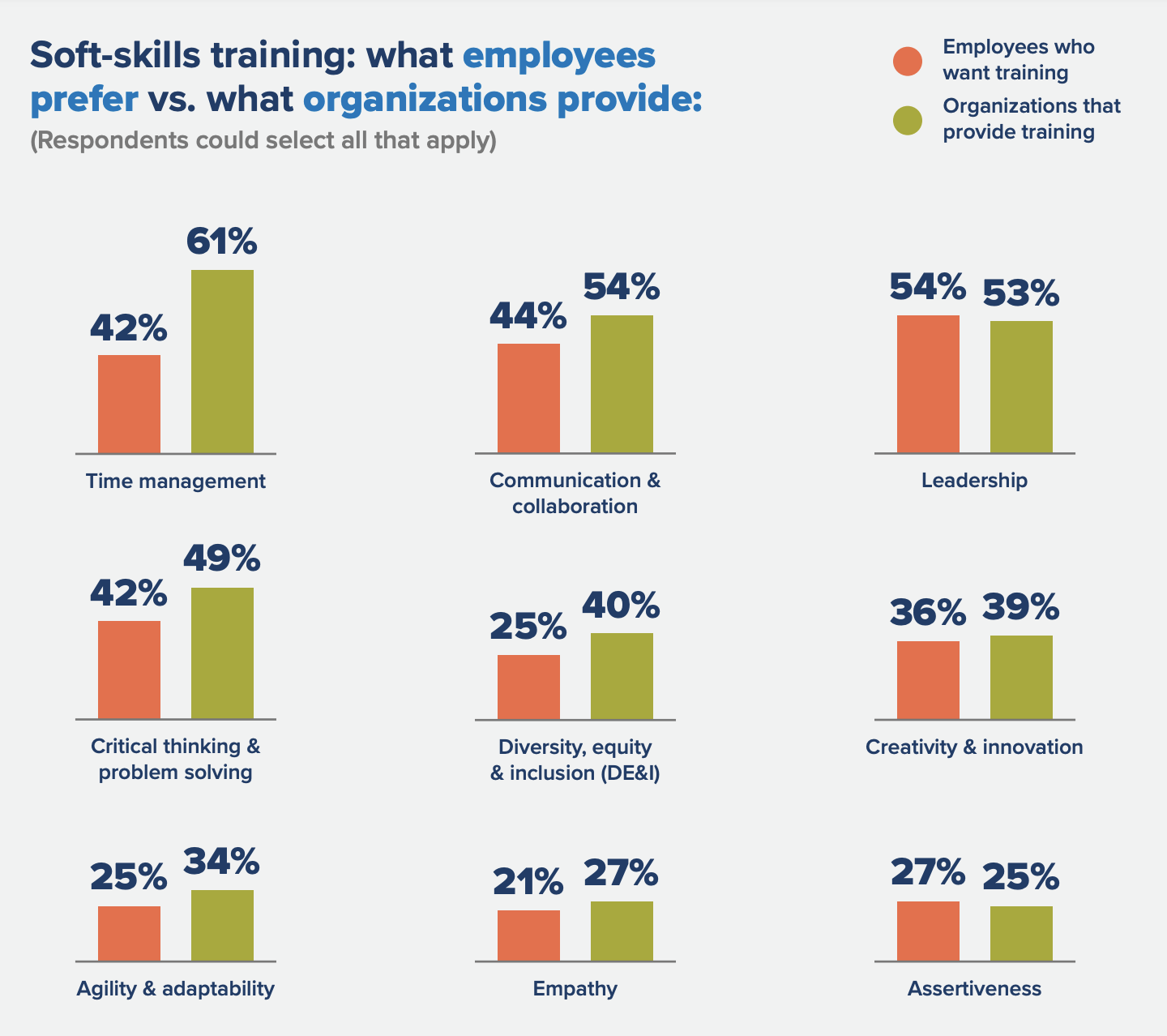Investing in your employees can serve as a recruitment and retention tool when so many workers are heading out the door amid the current Great Resignation. New research from SHRM Research and TalentLMS found that 86 percent of HR managers believe training aids in retention and 83 percent said it's a recruitment tool.
But how you deliver learning and development (L&D) is crucial if you want a return on your investment, the Society for Human Resource Management (SHRM) said in its 2022 Workplace Learning & Development Trends report.
"Organizations must maintain a steady growth of knowledge and skills among their workforce if they wish to succeed—both from a business standpoint and to attract the right talent," said Jim Link, SHRM-SCP, CHRO at SHRM.
Members of Generation Z, for example, want to work at organizations where they can develop their skills.
A whopping 75 percent of employees said they are satisfied with their training, but organizations need to look closely at how often workers receive training, their preferred method of learning and the training's relevancy to their immediate jobs.
Organizations also should heed workers' desire to develop soft skills in areas such as leadership and communication and collaboration.
The findings are based on an online survey conducted Jan. 29 to Feb. 20, 2022, with 1,001 U.S. workers who received employer-provided training in the 12 months prior to the survey. A sample of 356 U.S.-based HR managers who oversee or are involved in learning and development at their organization was surveyed during the same period.
SHRM Research found that:
- 55 percent of workers said they need more training to perform their job more effectively, and 38 percent want training that is more relevant to their current role.
- 32 percent want training to have a social element, such as peer-to-peer learning or learning groups.
A 2016 survey conducted for Harvard Business Review found that more than half of 512 respondents (55 percent) said they ask their colleagues for guidance when they need to learn something new; 69 percent seek out their boss or mentor. In addition:
- 32 percent want to be sure what they are learning is current. When recruiters for global staffing firm ManpowerGroup had to quickly learn to use a newly implemented applicant tracking system (ATS), they were able to access a digital adoption platform that helped them learn the new system "at the moment of need."
- 31 percent want more control over the training programs, including being able to choose methods and formats that match their learning style and development opportunities that make sense for their career progression.
Instruction using simulations was the most popular choice (64 percent) among nine different methods that included coaching/mentoring (51 percent), video (50 percent), webinars/lectures (38 percent), textbooks and other print materials (34 percent), micro-learning (32 percent), audio/podcasts (25 percent), role-playing (19 percent), and blogs and other Internet sources (17 percent).
When it comes to the soft skills employees want to develop and what employers provide, there are some discrepancies, according to the SHRM/TalentLMS report. For example, 61 percent of employers provide time management training, but only 42 percent of respondents said this was an area where they wanted training. Employers and employees are more closely aligned around leadership skills: 54 percent of respondents said they want this training, and 53 percent of employers provide it.

Source: State of the Workplace: Learning ad Development Research Report, 2022
"Workplace training impacts another key pillar of people-centric organizations—and that is employee journey," said Dimitris Tsingos, co-founder and president at Epignosis, the company behind TalentLMS. "Reinforcing positive employee experience is a leading training goal for over 9 in 10 HR managers, our research revealed, showing that L&D is crucial in shaping employee experience and creating a positive and caring culture."
The desire to increase or enhance their skills is leading some workers to pursue training on their own, outside of the workplace, with more than half saying they do so because they like learning new things and want to enhance their ability to develop their career (57 percent and 54 percent, respectively).
Only 27 percent said they are doing so because they want to change careers.
Keeping this desire for training in mind, "organizations may want to consider offering in their benefits packages an annual personal learning stipend for employees to use as they like," SHRM researchers noted in their report. "Few organizations do this currently; however, a benefit like this helps cultivate a development mindset among employees and encourages learning outside of work, further supporting a learning culture."
[SHRM members-only sample policy: Professional Training, Certification and Membership Policy]
Barriers to Training
For employers, budget is often a barrier to L&D. More than half of HR managers (54 percent) said their leadership does not view it as an investment; 52 percent encounter resistance when seeking L&D budget approval.
So how much do organizations spend per employee? It tends to fall between $501 to $3,000; 29 percent of HR managers said their organization spends $501 to $1,000, and 28 percent said they spend $1,001 to $3,000. Only 9 percent said they spend less than $500 per employee, while 15 percent spend $3,001 to more than $5,000 per employee.
Other top barriers, HR managers said, were a lack of time to administer training (33 percent) and difficulty keeping content current amid changes in the workplace (32 percent).
For employees, lack of motivation was a top barrier to L&D, cited by 33 percent; one-quarter said they soon forgot what they learned or they didn't have enough time at work to complete training.
Employers can overcome barriers to L&D, SHRM researchers pointed out in the report, by creating a culture where learning is valued, aligning skills development with the organization's goals and meeting employees' training needs.
Employers can do this by:
- Regularly surveying workers to find out how the organization can better meet their training needs.
- Considering the promotion of "learning ambassadors" who connect with other team members pursuing similar training or certifications and build mentoring relationships.
- Recognizing employees in staff communications who reach training goals, such as earning credentials or college degrees.
An organization run by AI is not a futuristic concept. Such technology is already a part of many workplaces and will continue to shape the labor market and HR. Here's how employers and employees can successfully manage generative AI and other AI-powered systems.




